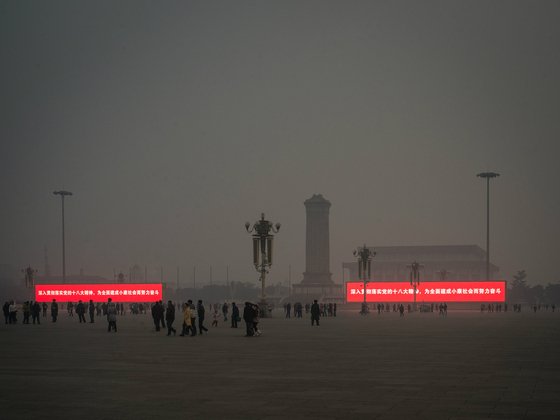新年伊始,中外对话邀请5位中国环保领域的代表人物,对2016年的中国绿色转型进行展望。
 图片来源:Lei Han
图片来源:Lei Han
我们问了两个问题:2016年,中国环境领域有哪些值得关注的动向?你对新一年的绿色转型有何期待?从这5份侧重点各异的答卷中,我们看到了一张有趣的拼图。“雾霾”、“监督”和“参与”等高频词汇,看起来仍将占领2016年中国环保头条。
杨富强 自然资源保护委员会(NRDC)气候、能源和环境高级顾问
2016年是中国十三五规划的开局之年,一定要做好。这要求我们用中央政府提出的“生态红线”理念来指导十三五能源规划,并能在6月之前完成规划的制定。这份规划中有几个重要议题值得外界关注:首先是能源消费总量控制,尤其是煤炭总量控制是否在规划中得到重视;其次是几个强制性能源措施:如十三五期间的能源强度下降目标是否不低于18%,碳强度下降目标是否不低于20%,2016年的可再生能源比例目标能否超过12.5%。碳排放总量控制也应该在今年开始实施,为2017年的碳交易市场启动做好准备。
中国现在把“去产能”作为2016年经济五大任务的首位。对于煤炭行业和煤炭的主要消耗行业钢铁、水泥、建材等,去产能都将是今年主要方向。应该吸取去年大面积雾霾的教训,抓好占煤耗30%的散烧煤的管理,同时现有的6000多家煤炭生产企业需要减半。我们预估2016年中国煤炭消费量将下降2.5%到3%。
在电力行业中,除非有中央特许,应该停止煤电的审批。核电的发展也应该以安全、稳健和高效为前提,年内不应发展内陆核电。与去年相比,今年应该进一步减少弃风弃光,并讨论可再生能源市场配额制,这可以减少对可再生能源的补贴。今年的电力改革特别值得关注的地方是售电端的放开,像阿里巴巴这样等有能力帮助消费端节能的企业将有可能参与进来。
今年中国将举办G20峰会,我们希望看到这20个排放大国显示他们在实施国家自主减排贡献(INDC)方面的进展,并在资金问题上进一步弥合缺口。今年中国的一带一路战略将开始启动,亚洲基础设施投资银行(AIIB)也将确定项目开始投资。我们应该关注政府、企业、NGO如何促使它更好地推动发展中国家的共同富裕,同时走一条可持续的绿色道路。
王华 环境保护部环境与经济政策研究中心研究员
雾霾已成为我国社会最为关注的环境问题,既影响大众身体健康,又影响经济发展甚至社会稳定。然而目前无论是从自然科学角度还是从经济学角度看,我国对雾霾治理的认识和理解都很缺乏,从而导致治理的力度和效果都不能令人满意,期待在2016年这方面能有所突破,从而使得雾霾治理能更加经济、有效。
在2016年,我国环境执法能力和力度应该能够得到大幅提升。在国际上,我国环境执法能力弱、守法程度差的问题一直“臭名昭著”。但随着新《环境保护法》的实施,我国环境执法力度在2015年得到显著加强,一系列的环境行政体制改革和司法体制改革开始启动。2016年,中央层面上的环境机构及职能设计会进一步合理,中央对地方的监督协调力度会进一步加强,行政力量和司法力量对企业的违法违规行为将会产生更加有效的制约。
在2016年,我国的环境社会运动会更加广泛、成熟、有序、有效。可以说,如果没有社会力量的全方位参与和推动,我国环境污染的控制以及生态环境质量的改善最多只能是局部的、缓慢的,环境资源使用者和破坏者不会轻易放弃经济利益而投入更多资源到环境保护中去,仅有行政以及司法力量的加强不足以显著推动我国环境质量的改善。我国民众已经觉醒,尽管力量还很薄弱。期待在2016年我国社会力量在推动环境保护方面能发挥显著作用。
高胜科 《财经》杂志记者
环保部在2015年掀起了“环评红顶中介整治风暴”, 现在应关注风暴能否持续,针对环评市场的诸多乱象是否有进一步专项整治措施,以及《环评法》修订与环评改革能否厘清思路并大刀阔斧实施。因为顽疾已久,一阵风的风暴难以彻底祛“毒”。
在国家力推“简政放权”的背景下,环保部门的审批、监督放权,能在2016年得到怎样的实施成果令人拭目以待。因为地方环保部门在人力资源、专业水平上的束缚是长期以来的现状,而“放权”之后是否具备能力做好项目把关、环保监督,为业内人所忧虑。因此,2016年,国家与地方的环保部门在“事”与“权”方面的界限能否清晰,将关乎环保简政放权改革的成败。
此外,在“大气十条”、“水十条”相继出台后,外界都在关注作为土壤治理重要纲领的“土十条”能否在2016年出台。紧随其后,其决策的科学、合理性与实施的有效性有待进一步评估。
张伯驹 自然之友总干事
2016年,中国的环境法治和公众参与将有更多行动空间与可能性。 2015年新《环境保护法》生效后,2016年1月1日新《大气污染防治法》也将开始实施,环保组织和公民有了更多法律依据通过法律手段保护环境公共利益和自身权益。随着法院、律师、环保NGO在环境法领域的实践与成长,我们预计2016年环境公益诉讼的数量和质量都将有所提升,也会看到更多富有针对性的系列案件及预防性案件,如针对大气污染、土壤污染和物种保护等。一些倡导性诉讼也可能应运而生,它们并非着眼于特定的环境生态破坏问题,而是用以揭示法律法规缺失或决策的局限性,以促进这些问题的解决。同时,行政环境公益诉讼的突破也值得期待。
在公众参与方面,随着环境影响评价重心从项目环评逐步转向规划环评,公众参与被进一步前置。当面对更大的公众参与空间时,能否有足够专业性和动员能力有效参与和推动改变,将成为环保组织和绿色公民们必须回应的一个课题。
解焱 中科院动物研究所副研究员
2016年生态保护领域的一个重要进展是新版《野生动物保护法》。该法第一次公开征求意见稿已于2015年底发布,2016年修订版本必将颁布。新版将野生动物栖息地保护纳入到法律中。“重点野生动物名录”修订也将成为常规性工作,而不是如之前的“野生动物重点保护名录”那样,30年后仍很难进行修订。修订版强调了野生动物保护对生态和社会的价值。不过该版本中仍然将野生动物合理利用作为指导原则之一予以保留,让《野生动物保护法》似乎变成了《野生动物利用法》,相信这方面的争论在今年将成为焦点。
过去一年,中国对国家公园体制启动了深入研究。在对国家级自然保护区投入增多,保护力度加强的情况下,中国对超出自然保护区范围的,更加全面的自然保护地的认识和保护将得到加强。相信2016年将对自然保护地相关法律法规进行研究,推动自然保护地的保护力度。虽然因为涉及管理部门众多,在短期内恐怕很难制订出一部管理法律,但是对自然保护地的重要意义认识却由此获得了极大的提高。

